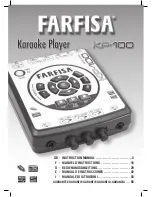
24
5 MAINTENANCE
This equipment must be inspected and serviced annually by a qualified professional in order
to maintain optimum efficiency and reliability and to prevent degradation or damage which
may
not
be covered by the product guarantee.
We recommend the system is serviced annually prior to the coldest months of winter.
In addition to annual servicing by a qualified professional, the system should be checked
periodically by the end user to identify any potential problems as soon as possible in the
unlikely event that they might occur.
5.1 Periodic System Check
On a regular basis, check the system pressure by reading the pressure gauge on the pump
station (refer to Figure 19 on Page 19). The pressure should be no less than 3 bar and no
more than 6 bar. If the pressure is outside this range, contact your installer / service
engineer.
5.2 Annual Maintenance
Using a proprietary test kit, assess the health and performance of the system by carrying out
the following checks.
5.2.1 Check installation
Check for any signs of physical damage to the system and repair if necessary.
Visually inspect the installation for any signs of leakage, particularly if the system pressure
has fallen below 3 bar. Any leakage
must
be rectified and the system re-pressurised and
bled using Warmflow Solar Fluid (SF~) and an appropriate filling station.
5.2.2 Check fluid health
CAUTION:
The fluid may be
EXTREMELY HOT!
Draw off a small amount of fluid via the bleed point using a section of suitable 8mm ID hose
(secured in place with an appropriate jubilee clip) to safely discharge the fluid into a suitable
container.
Visually inspect the fluid. When the fluid is new it is light green in colour, transparent and
has the consistency of mildly soapy water. If it is dark brown in colour, or has become thick,
it has degraded and should be replaced. Depending on the severity of the degradation,
flushing may be required before refilling. Consult the flushing fluid manufacturer.
Check the pH of the fluid. If it is 7.0 or less the fluid must be replaced.
5.2.3 Check performance
If there is adequate solar gain on the day of servicing, check the performance of the
installation by measuring the flow and return temperatures vs. the solar insolation.
Check the calibration of the T2 and T3 tanks sensors. They should measure within a few
degrees of a thermometer inserted in the tank sensor pockets.
Discuss the performance of the system with the end user. If they report the performance to
have decreased, and there is insufficient solar gain on the day of servicing to check, it may
be necessary to gain access to the roof to check the vacuum tubes. If any getters have
turned white the tube(s) affected will need to be replaced.
Summary of Contents for Solar SHP20
Page 2: ......







































